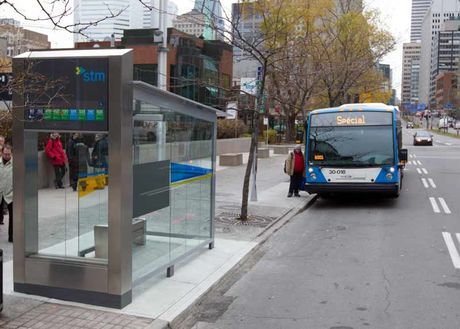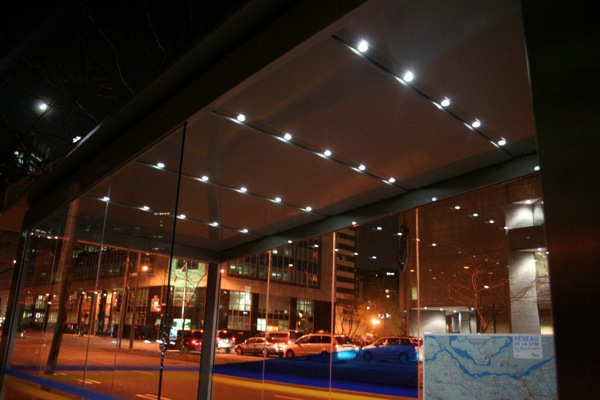I guess I do have some issues with the Arlington bus shelters
Months ago I defended the alleged high cost of Arlington County's new proposed bus shelters because of the materials, size, and intent ("Arlington County's bus shelters and a public realm framework of quality"). Public outcry led to a redesign and cost engineering so that the new shelters will cost less according to press reports earlier in the week ("No more 'million dollar bus stops in Arlington," Washington Post; "Pike ‘Super Stops’ Redesigned, Cost Nearly Cut in Half," ArlingtonNow).
But in thinking about this more, I have a number of reservations.
But let me start by saying that I believe wholeheartedly in creating signature bus/transit stops as part of the wayfinding and marketing of transit as well as improving the quality of the customer experience, as outlined in the past blog entry, "Making bus service sexy and more equitable," among others.

New prototype, Arlington County signature bus shelter.

Old prototype, Arlington County "Super Stop" bus shelter. Both images from Arlington Now
(1) The shelter design is pretty clunky, too hulking (it reminds me of the old shelters in the Portland Transit Mall, which were overly large and out of scale). The earlier prototype was much more attractive, although it had some issues too.
(2) it's still expensive.
(3) it doesn't appear to provide much protection from the weather, which to my way of thinking is one of the most important elements in providing transit shelters.
With regard to points 1, 2, and 3, STM in Montreal created their own new version of a bus shelter a few years ago which is very attractive, inexpensive, and in my opinion at least a far better design than the Arlington version ("The stm's new bus shelters won't cost $16,000," Montreal Gazette).

Original STM new bus shelter prototype. Because of cold winters, the shelter has a glass front, and people enter the shelter from the rear. Photo: Allen McInnis, The Gazette.
Notably the cost of this shelter was supposed to be less than $20,000, although that was for the cost of the shelter only, and didn't include installation. Adding electricity connections and making them in larger sizes would cost more, as would adding digital advertising capabilities, which weren't included in this prototype. It also has night time lighting, although some people complained that the amount of lighting was insufficient.

Image from the Fagstein blog.
(4) And it reminds me of another problem in civic infrastructure, that many jurisdictions are focused on designing their own "unique" products rather than using "off the shelf" designs that may be better and cost less to implement.
Years ago, I remember reading a comment by the then director of the San Diego transit system MTS, commenting about heavy rail systems and the fact that because most heavy rail systems employ unique cars designed specifically for their system, they cost a lot more per copy than they would if there were standardized equipment. This appears to be the case with the Arlington project, although when you add in site design and other costs, it's hard to drill down to the shelter cost as a distinct element, versus the total cost.
The opposite impulse was when the streetcar industry came together in the 1930s to create a standardized car, the "PCC" ("President's Conference Committee"), where streetcar companies across the nation worked together to create a standardized design and committed to purchasing the car in great quantities to bring the price down.
(5) Plus, Arlington County doesn't allow advertising in their transit shelters. I can understand a reticence for doing so because of concerns about monetizing the value of public space in ways that can cheapen it.
(6) On the other hand, advertising in the public space can subsidize the cost of new transit-related street furniture and in the jurisdictions where there is great value for advertising, advertising companies will provide the shelters "for free" in return for the ability to sell advertising. And now that digital advertising is possible within shelters, the potential profits for both parties (the company and the local government) are even higher ("Electronic billboards attractive to cities," San Diego Union-Tribune), with billboard companies highly motivated and willing to provide a greater revenue split in favor of the locality.
Note that many companies do these kinds of deals including CBS Outdoor, Cemusa (NYC), Clear Channel/Adshel (DC), JC Decaux (e.g., Boston, San Francisco), etc. And for those communities that don't want to work with those companies, they can buy transit shelters "off the shelf" from various companies such as Tolar Manufacturing.
(7) And with new digital capabilities, it's possible to add information and other services to transit shelters that significantly improve the experience.
For example with regard to points 5, 6, and 7, STM has since moved on from providing their own shelters to developing a contract with Quebecor, which will provide new transit shelters (STM press release), some with incredible digital information systems, at no cost to STM, and with a revenue split. The Quebecor design appears to be based on the STM design from 2011.
---------
Note that when I produced the pedestrian and bicycle plan for Baltimore County few years ago, I had a section on transit infrastructure (although almost all of the design related recommendations in the plan were excised from the posted draft, including that section). For the most part, the recommendations on transit stops and stations were drawn from the publication Transit Waiting Environments, which was produced by the Kent State University Community Design Center for the Cleveland transit system.
The report categorized five different types of stops, with a requisite package of amenities and design characteristics, depending on the location, number of riders, and place within the hierarchy of types.
Labels: civic assets, civic engagement, public realm framework, transit infrastructure, transportation planning, urban design/placemaking



1 Comments:
In this area, you need three things:
1. Shade
2. Next Bus
3. A map showing where the bus line goes.
I'd glad Arlington has brought the price down from Insane to expensive. I'd say they probably saved 50K but not having someone do those rendered pictures.
And yes every city doing it on their own is great for vendors.
The ban on advertising may be a state thing. I do have to say the bikeshare ads are pretty ugly and don't add much.
Post a Comment
<< Home